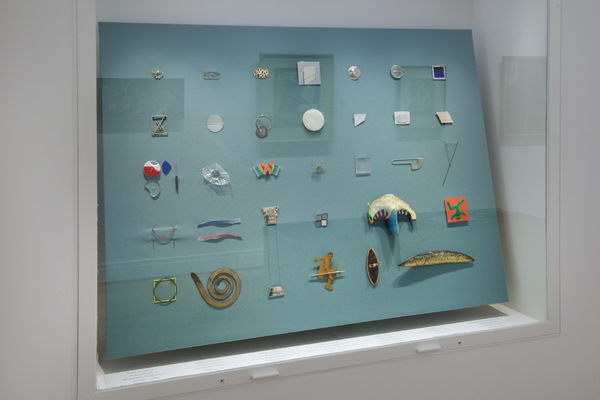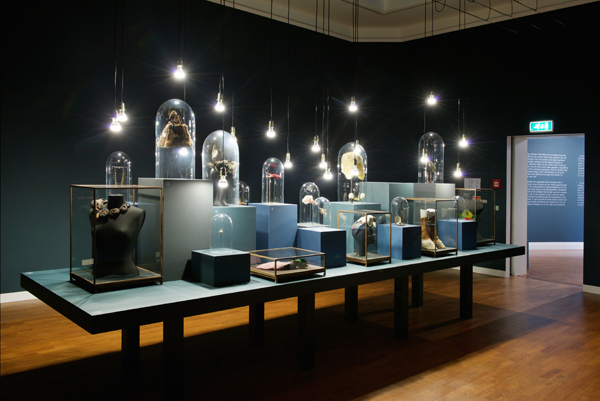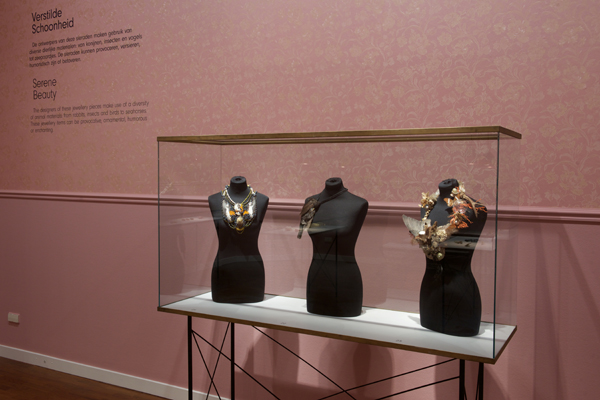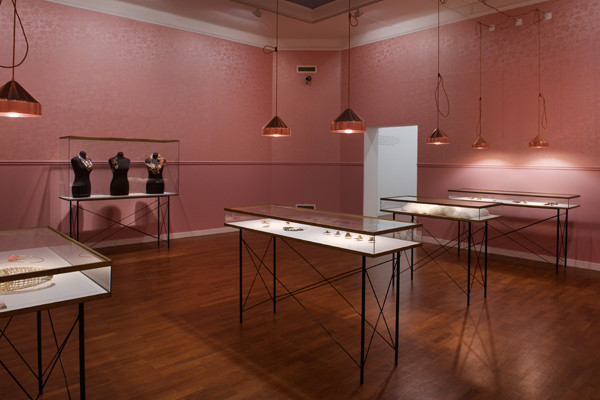Recently, Eveline Holsappel, curator at the Museum Arnhem in the Netherlands, put together an exhibition of contemporary and fashion jewelry and accessories focused on what artists are doing with taxidermy. It is called Beauty of the Beast and for more about the show see the AJF review. The exhibition includes the work of Merel Bekking, Julia DeVille, Niels van Eijk and Miriam van der Lubbe, Kate Gilliland, Idiots, Ben Lignel, Kelly McCallum, Kate MccGwire, Märta Mattsson, Ted Noten, Reid Peppard, Iris Schieferstein, Simei Irene Snyman, Tinkebell, Charlie Tuesday Gates, Cecilia Valentine, Emily Valentine, Christel Verdaasdonk, Tanel Veenre, and Lisa Walker. For those of us who love the beauty of animals, the macabre aspect of taxidermy and the creativity of the artists in this show is fascinating.

The Museum Arnhem also has a permanent collection of jewelry, which dates back to the 1960s; part of it is on continuous display.
Susan Cummins: Can you tell the story of how jewelry became the focus of a collection at the Museum Arnhem? Who was responsible for it?
Eveline Holsappel: It started in the late 1960s when Riet Neerincx was the curator of applied art at Museum Arnhem. She was also a goldsmith and very up to date with developments in jewelry design at the time. At the academy in Arnhem there was a group of young students who were revolutionizing jewelry design. Neerincx started collecting their work, which meant Museum Arnhem was one of the first museums in the Netherlands to collect contemporary jewelry. She continued to collect modern Dutch jewelry and organize jewelry exhibitions, providing a platform for young designers to show their work.

Is it mostly Dutch jewelry?
Eveline Holsappel: Yes, the focus is on Dutch jewelry, but there are some non-Dutch pieces, mainly British and German.
There are several museums in the Netherlands that have significant collections of Dutch jewelry. What are the strengths of the Arnhem collection? What distinguishes it?
Eveline Holsappel: The museums in the Netherlands with Dutch jewelry collections all have their own focus. Ours is to show the developments in Dutch jewelry from the 1970s ’til the present day. Some jewelry designers, we follow throughout their career. We just installed a permanent collection display with brooches from the 1960s ’til 2014, and a case showing work by Lucy Sarneel, whose work we have been collecting for over 30 years. I think it is important to add that our museum also has a strong collection of figurative art from the early 20th century ’til the present, an applied art and design collection, and an international contemporary art collection. Now that the boundaries between the disciplines are disappearing, we see jewelry very much in the context of fine art and design and also want to show it like that in exhibitions and in our permanent display.

Eveline Holsappel: Our museum has three curators—one for contemporary art, one for applied art pre-1900 (she is based at Rozet, where our historic collection is shown), and me, the curator of applied art and design post-1900. Our collection mainly consists of Dutch jewelry, ceramics, and glass. I am responsible for the collection, doing research, proposing acquisitions, and making exhibitions. Before my current job, I first worked in the National Museum in Wales, in Cardiff, where I mainly concentrated on 18th-century porcelain, which is quite a different subject! I then became the curator of the Crafts Council collection in London. There was some contemporary British jewelry in this collection, so I had a little bit of knowledge of contemporary jewelry before I came to Arnhem, but I learned mostly on the job.
You have just had a jewelry show called Confrontations: New Traditional Jewellery, which is a biennial international design competition. What is the museum’s history with this? Is it something you have hosted in the past? Will the museum be acquiring something from this show?
Eveline Holsappel: This was the third time we hosted the show. There is always a theme; this year it was Confrontations. The jury selected about 45 pieces. They give a great overview of the current state of jewelry design from all over the world. The competition gets more international with every edition, which is very exciting.

Eveline Holsappel: Yes, I curated the show. The idea started about two years ago when I noticed that taxidermy had become fashionable again. Damian Hirst introduced it in fine art in the 1990s, and, some years later, Alexander McQueen in fashion. It is now becoming mainstream and appearing everywhere, in magazines and trendy shops and restaurants. Because we have a focus on jewelry in Museum Arnhem, I wanted to look at makers who combine taxidermy and jewelry. I also included fashion accessories. The result was a very interesting selection of work by 20 international artists, including a handbag made from a fox, a bra from birds, a brooch from seahorses, and many other objects. To explain that this is not just something that is happening today, I also included some 19th-century pieces, like a pair of beautiful hummingbird earrings. The designers in the exhibition, surprisingly mostly young vegetarian women, use roadkill, waste from the processing of meat, and killed vermin for their work. They want to raise questions about the relationship between humankind and animal. On the one hand we eat meat, kill vermin, and wear leather shoes; on the other, there is aversion to fur, industrial farming, and hunting. People keep one mouse as a pet but kill another as a pest. We want visitors to think about these issues and at the same time be amazed by how beautiful the animals are.
Does the museum continue to collect jewelry? What is your focus? What is the process for accepting something? And who is supplying the funding for these acquisitions?
Eveline Holsappel: Yes, we continue to add to our collection of Dutch jewelry. The aim is to keep the collection up to date and show the latest developments. One of our last acquisitions is a great piece by Noon Passama. We get money for acquisitions from several sources, but the city council, the Mondriaan Foundation, and the Bank Giro Loterij (lottery money) are our main funders.

In the United States, several collectors have donated large collections of jewelry to major museums. Have you ever received a substantial collection from a Dutch collector?
Eveline Holsappel: In 2009 we were very happy to receive a large gift of mainly Dutch jewelry and a few international pieces from an important collector from the Netherlands. It was a great addition to the existing collection.
What does the future look like for the museum?
Eveline Holsappel: It will be an interesting time for the museum. There are plans to extend our current building, so there will be more space for exhibitions and our permanent collection. We are celebrating our centenary in 2020, and hopefully that will be in an exciting new extension with lots of space for our applied art and design collection, including many pieces of jewelry!
Thank you.




